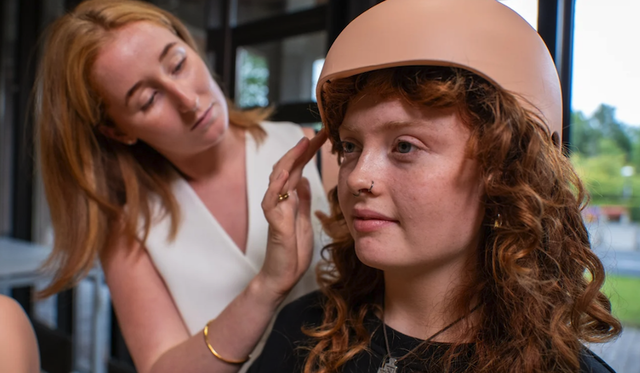Having witnessed how upsetting it is for cancer patients who face losing their hair during chemotherapy when her mother went through it in 2019, the 24-year-old was inspired to create a device that helps prevent hair loss by scalp cooling.
Scalp cooling can help prevent hair loss by shrinking the blood vessels and is done by applying cold temperatures to the scalp during chemotherapy treatment.
It works by limiting blood flow to the scalp. This can reduce the amount of the chemo treatment that reaches your head, protecting your hair follicles from the chemo drugs.
Olivia noticed the shortage of scalp-cooling machines aimed to minimize hair loss in the hospital her mother was in, as well as how limited the existing solutions were.
Current products require the patient to arrive 30 minutes early and stay for 90 minutes after infusion for pre and post-scalp cooling.
With Athena, patients can manage this aspect of treatment themselves and seamlessly integrate into an infusion appointment with no extra time or attention required, using this device from the comfort of their own homes.
Athena works by utilizing low-cost thermoelectric semiconductors called peltiers, and these cool a tank of water, which circulates the cold water around the head with the smartly designed headpiece.
The battery-powered device allows patients to bring the device home and control it themselves, making it more accessible to the consumer market.
The estimated cost for Athena would be around €1000, according to Humphreys, compared to industry machines which come in at around €40,000 or more.
Weighing around 3kg, the device is more portable than the current leading products on the market, which use refrigeration technology requiring constant plugged-in power.
Athena, at full battery power, can run for 3.5 hours, allowing the patient to commute to and from the hospital while cooling and moving around during infusion for bathroom visits, etc.
Speaking about Athena, Humphreys said: “I decided to build a working prototype to test the capabilities of the Peltier semiconductors.
“Using a Peltier computer cooling fan system, a diaphragm pump, my mum's old suitcase, and my dad's plane battery, I was able to create a strong proof of concept to gather valuable feedback to develop the concept.
“Following this, I focused on the product's form, creating cardboard and foam models and determining functionality aspects and touchpoints to ensure the best user experience.
“Ultimately, I arrived at my final model, Athena, which was crafted using SolidWorks 3D CAD modeling.”
To elevate Athena to the next level, Humphreys needs to conduct extensive research and development.
“While working on this project,” she says, “I have been fortunate to network with Luminate Medical, a company in Galway, Ireland, dedicated to building a better future for cancer care.
“They have extended an internship offer to me as a research and development engineer
I have accepted and am very eager to apply the insights gained from my own research and development to contribute to their mission.”
Speaking about Athena, Lead Design Engineer at Dyson James Gilchrist who was part of the judging panel, said: “The genius of Athena isn’t just in increasing access; it’s in taking the patient out of the clinic.”
Athena will now progress to the international stage of the James Dyson Award and Humphreys will aim to commercialize this product by producing a fully functional, technologically integrated prototype.




Comments